Financial Analysis and Management (Part 2)
VerifiedAdded on 2023/04/04
|13
|3481
|442
AI Summary
This document discusses the evaluation of external sources of finance for public listed business entities, considerations for selecting financing sources, and the concept of Weighted Average Cost of Capital (WACC). It provides an in-depth analysis of equity financing, bank loans, venture capital, factoring, and government grants as external sources of finance. The document also highlights the factors that must be considered by firms when selecting a financing source, such as risk, cost, control, and legal implications. Additionally, it explains the concept of WACC and its significance in determining the cost of capital for a company.
Contribute Materials
Your contribution can guide someone’s learning journey. Share your
documents today.
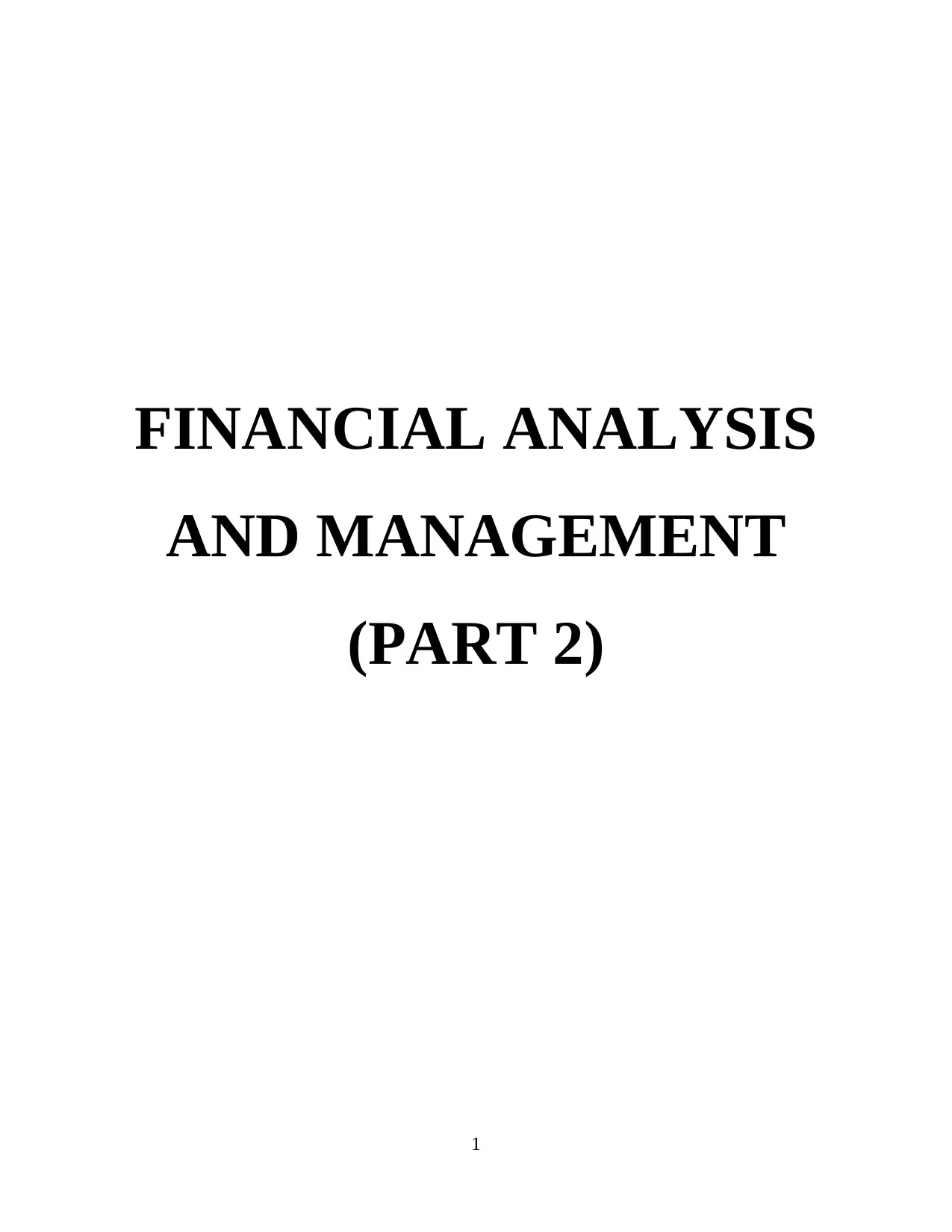
FINANCIAL ANALYSIS
AND MANAGEMENT
(PART 2)
1
AND MANAGEMENT
(PART 2)
1
Secure Best Marks with AI Grader
Need help grading? Try our AI Grader for instant feedback on your assignments.
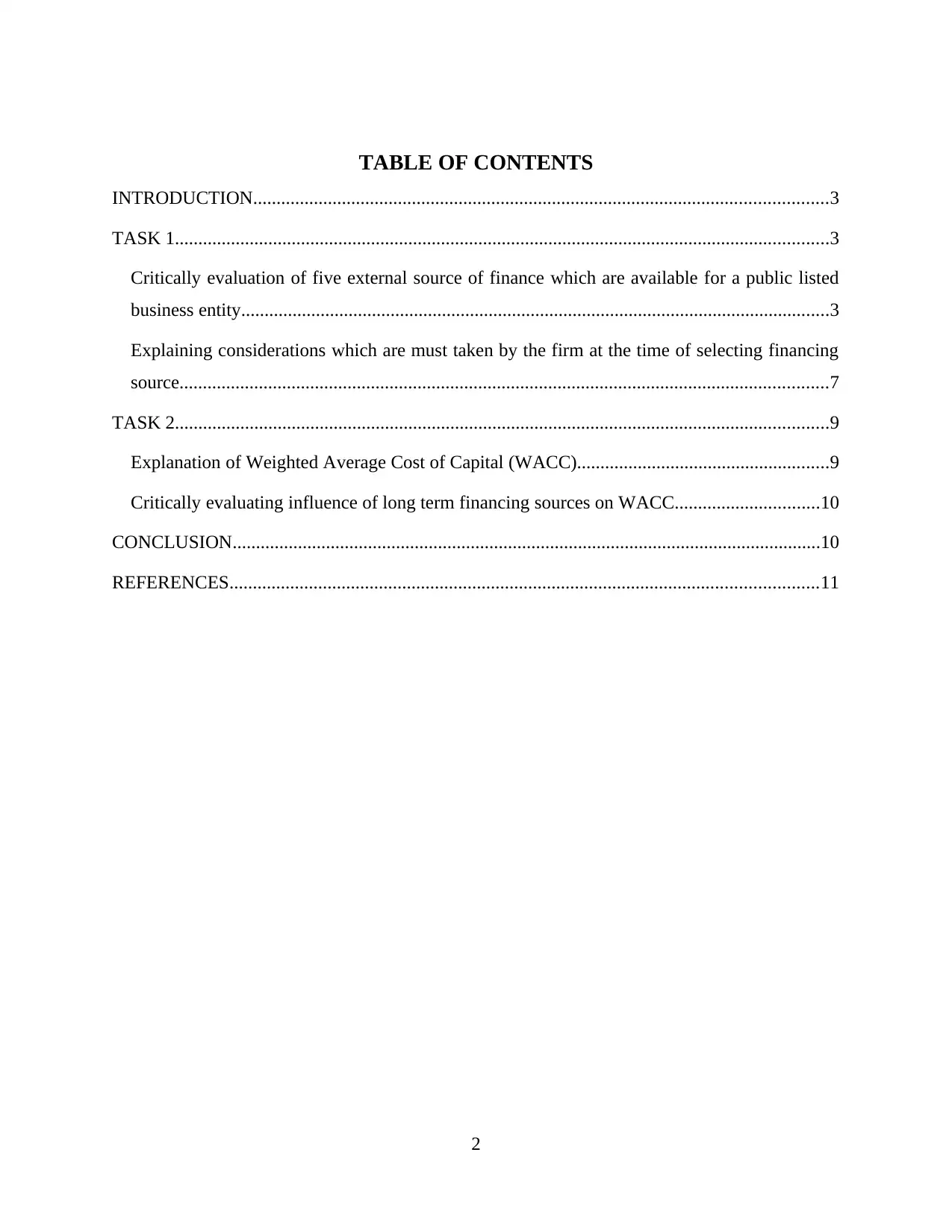
TABLE OF CONTENTS
INTRODUCTION...........................................................................................................................3
TASK 1............................................................................................................................................3
Critically evaluation of five external source of finance which are available for a public listed
business entity..............................................................................................................................3
Explaining considerations which are must taken by the firm at the time of selecting financing
source...........................................................................................................................................7
TASK 2............................................................................................................................................9
Explanation of Weighted Average Cost of Capital (WACC)......................................................9
Critically evaluating influence of long term financing sources on WACC...............................10
CONCLUSION..............................................................................................................................10
REFERENCES..............................................................................................................................11
2
INTRODUCTION...........................................................................................................................3
TASK 1............................................................................................................................................3
Critically evaluation of five external source of finance which are available for a public listed
business entity..............................................................................................................................3
Explaining considerations which are must taken by the firm at the time of selecting financing
source...........................................................................................................................................7
TASK 2............................................................................................................................................9
Explanation of Weighted Average Cost of Capital (WACC)......................................................9
Critically evaluating influence of long term financing sources on WACC...............................10
CONCLUSION..............................................................................................................................10
REFERENCES..............................................................................................................................11
2
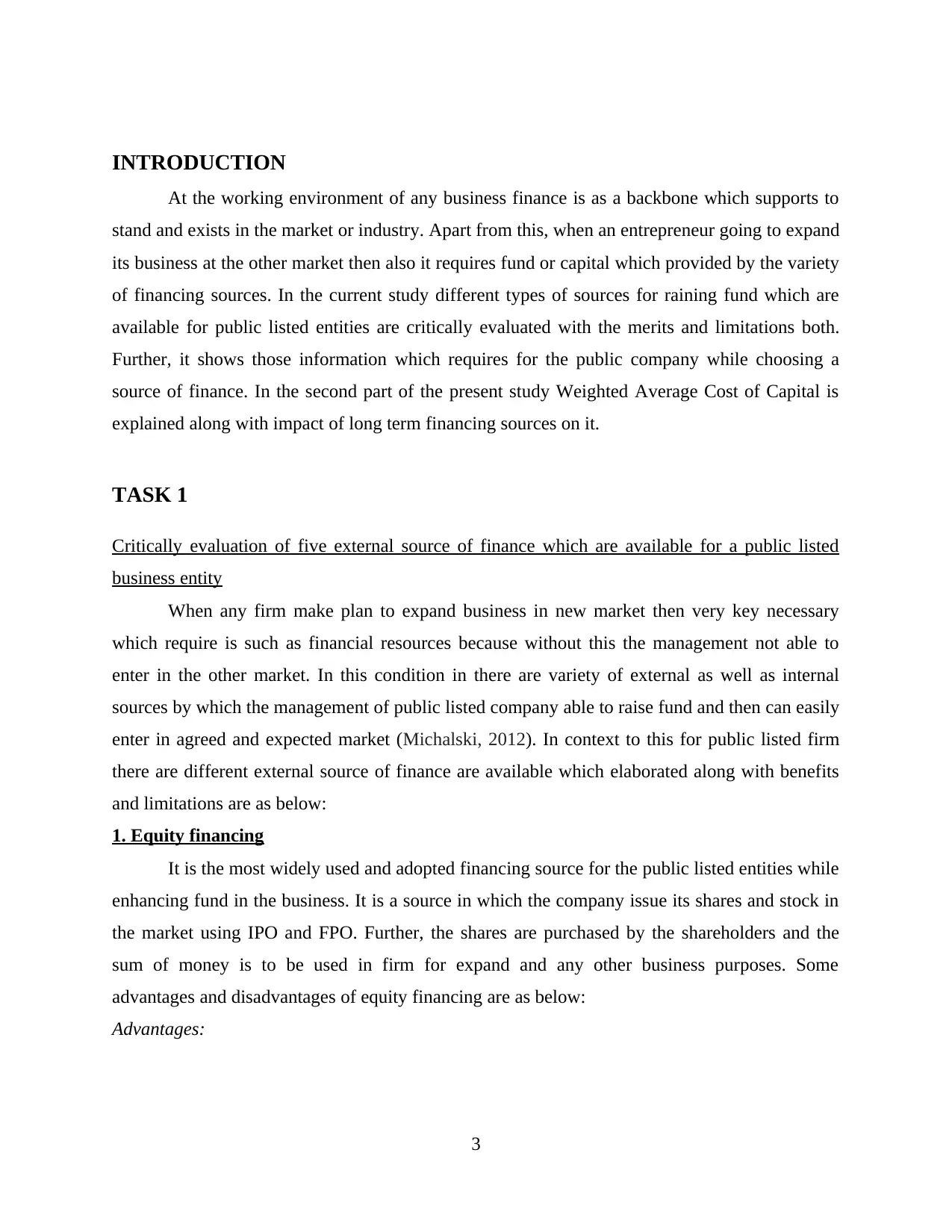
INTRODUCTION
At the working environment of any business finance is as a backbone which supports to
stand and exists in the market or industry. Apart from this, when an entrepreneur going to expand
its business at the other market then also it requires fund or capital which provided by the variety
of financing sources. In the current study different types of sources for raining fund which are
available for public listed entities are critically evaluated with the merits and limitations both.
Further, it shows those information which requires for the public company while choosing a
source of finance. In the second part of the present study Weighted Average Cost of Capital is
explained along with impact of long term financing sources on it.
TASK 1
Critically evaluation of five external source of finance which are available for a public listed
business entity
When any firm make plan to expand business in new market then very key necessary
which require is such as financial resources because without this the management not able to
enter in the other market. In this condition in there are variety of external as well as internal
sources by which the management of public listed company able to raise fund and then can easily
enter in agreed and expected market (Michalski, 2012). In context to this for public listed firm
there are different external source of finance are available which elaborated along with benefits
and limitations are as below:
1. Equity financing
It is the most widely used and adopted financing source for the public listed entities while
enhancing fund in the business. It is a source in which the company issue its shares and stock in
the market using IPO and FPO. Further, the shares are purchased by the shareholders and the
sum of money is to be used in firm for expand and any other business purposes. Some
advantages and disadvantages of equity financing are as below:
Advantages:
3
At the working environment of any business finance is as a backbone which supports to
stand and exists in the market or industry. Apart from this, when an entrepreneur going to expand
its business at the other market then also it requires fund or capital which provided by the variety
of financing sources. In the current study different types of sources for raining fund which are
available for public listed entities are critically evaluated with the merits and limitations both.
Further, it shows those information which requires for the public company while choosing a
source of finance. In the second part of the present study Weighted Average Cost of Capital is
explained along with impact of long term financing sources on it.
TASK 1
Critically evaluation of five external source of finance which are available for a public listed
business entity
When any firm make plan to expand business in new market then very key necessary
which require is such as financial resources because without this the management not able to
enter in the other market. In this condition in there are variety of external as well as internal
sources by which the management of public listed company able to raise fund and then can easily
enter in agreed and expected market (Michalski, 2012). In context to this for public listed firm
there are different external source of finance are available which elaborated along with benefits
and limitations are as below:
1. Equity financing
It is the most widely used and adopted financing source for the public listed entities while
enhancing fund in the business. It is a source in which the company issue its shares and stock in
the market using IPO and FPO. Further, the shares are purchased by the shareholders and the
sum of money is to be used in firm for expand and any other business purposes. Some
advantages and disadvantages of equity financing are as below:
Advantages:
3
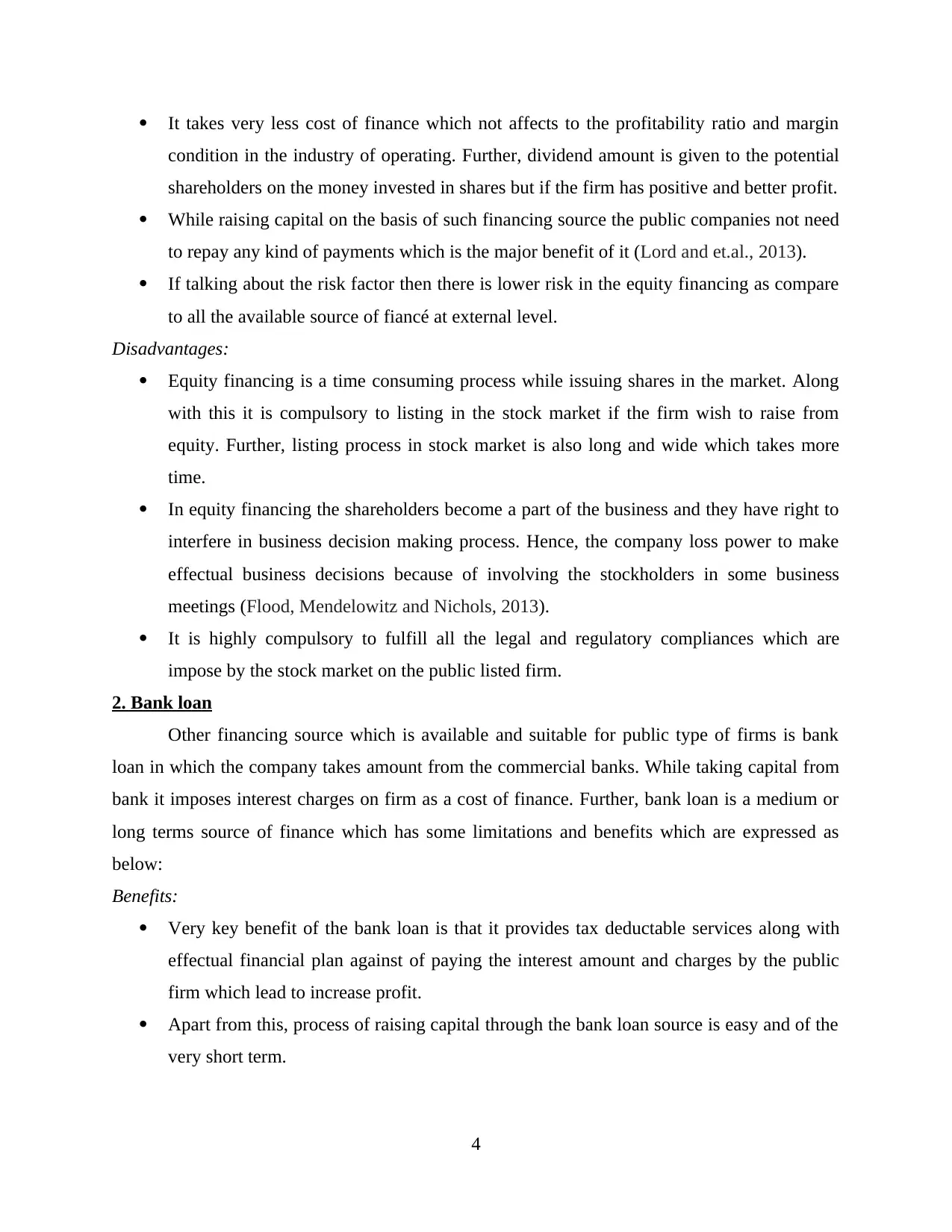
It takes very less cost of finance which not affects to the profitability ratio and margin
condition in the industry of operating. Further, dividend amount is given to the potential
shareholders on the money invested in shares but if the firm has positive and better profit.
While raising capital on the basis of such financing source the public companies not need
to repay any kind of payments which is the major benefit of it (Lord and et.al., 2013).
If talking about the risk factor then there is lower risk in the equity financing as compare
to all the available source of fiancé at external level.
Disadvantages:
Equity financing is a time consuming process while issuing shares in the market. Along
with this it is compulsory to listing in the stock market if the firm wish to raise from
equity. Further, listing process in stock market is also long and wide which takes more
time.
In equity financing the shareholders become a part of the business and they have right to
interfere in business decision making process. Hence, the company loss power to make
effectual business decisions because of involving the stockholders in some business
meetings (Flood, Mendelowitz and Nichols, 2013).
It is highly compulsory to fulfill all the legal and regulatory compliances which are
impose by the stock market on the public listed firm.
2. Bank loan
Other financing source which is available and suitable for public type of firms is bank
loan in which the company takes amount from the commercial banks. While taking capital from
bank it imposes interest charges on firm as a cost of finance. Further, bank loan is a medium or
long terms source of finance which has some limitations and benefits which are expressed as
below:
Benefits:
Very key benefit of the bank loan is that it provides tax deductable services along with
effectual financial plan against of paying the interest amount and charges by the public
firm which lead to increase profit.
Apart from this, process of raising capital through the bank loan source is easy and of the
very short term.
4
condition in the industry of operating. Further, dividend amount is given to the potential
shareholders on the money invested in shares but if the firm has positive and better profit.
While raising capital on the basis of such financing source the public companies not need
to repay any kind of payments which is the major benefit of it (Lord and et.al., 2013).
If talking about the risk factor then there is lower risk in the equity financing as compare
to all the available source of fiancé at external level.
Disadvantages:
Equity financing is a time consuming process while issuing shares in the market. Along
with this it is compulsory to listing in the stock market if the firm wish to raise from
equity. Further, listing process in stock market is also long and wide which takes more
time.
In equity financing the shareholders become a part of the business and they have right to
interfere in business decision making process. Hence, the company loss power to make
effectual business decisions because of involving the stockholders in some business
meetings (Flood, Mendelowitz and Nichols, 2013).
It is highly compulsory to fulfill all the legal and regulatory compliances which are
impose by the stock market on the public listed firm.
2. Bank loan
Other financing source which is available and suitable for public type of firms is bank
loan in which the company takes amount from the commercial banks. While taking capital from
bank it imposes interest charges on firm as a cost of finance. Further, bank loan is a medium or
long terms source of finance which has some limitations and benefits which are expressed as
below:
Benefits:
Very key benefit of the bank loan is that it provides tax deductable services along with
effectual financial plan against of paying the interest amount and charges by the public
firm which lead to increase profit.
Apart from this, process of raising capital through the bank loan source is easy and of the
very short term.
4
Secure Best Marks with AI Grader
Need help grading? Try our AI Grader for instant feedback on your assignments.
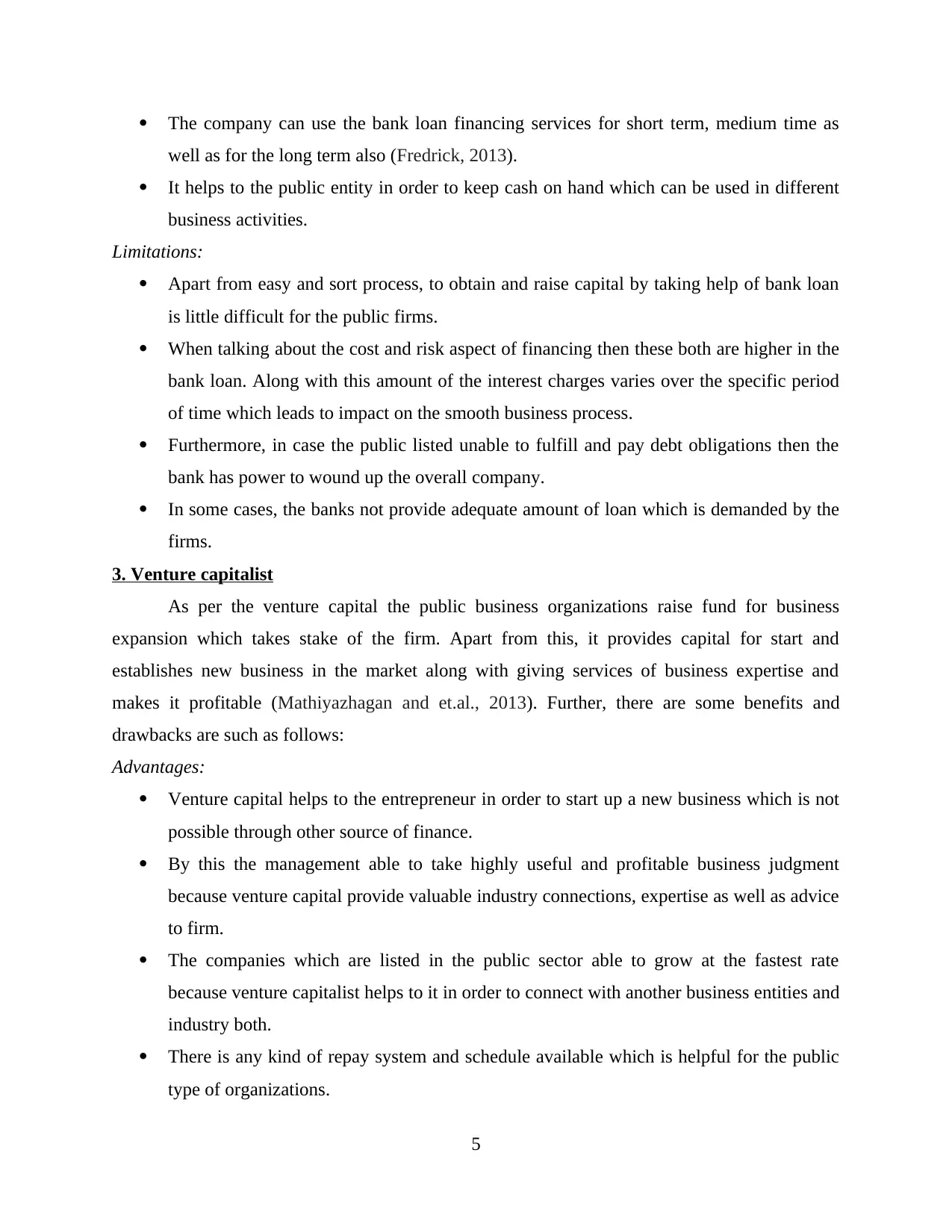
The company can use the bank loan financing services for short term, medium time as
well as for the long term also (Fredrick, 2013).
It helps to the public entity in order to keep cash on hand which can be used in different
business activities.
Limitations:
Apart from easy and sort process, to obtain and raise capital by taking help of bank loan
is little difficult for the public firms.
When talking about the cost and risk aspect of financing then these both are higher in the
bank loan. Along with this amount of the interest charges varies over the specific period
of time which leads to impact on the smooth business process.
Furthermore, in case the public listed unable to fulfill and pay debt obligations then the
bank has power to wound up the overall company.
In some cases, the banks not provide adequate amount of loan which is demanded by the
firms.
3. Venture capitalist
As per the venture capital the public business organizations raise fund for business
expansion which takes stake of the firm. Apart from this, it provides capital for start and
establishes new business in the market along with giving services of business expertise and
makes it profitable (Mathiyazhagan and et.al., 2013). Further, there are some benefits and
drawbacks are such as follows:
Advantages:
Venture capital helps to the entrepreneur in order to start up a new business which is not
possible through other source of finance.
By this the management able to take highly useful and profitable business judgment
because venture capital provide valuable industry connections, expertise as well as advice
to firm.
The companies which are listed in the public sector able to grow at the fastest rate
because venture capitalist helps to it in order to connect with another business entities and
industry both.
There is any kind of repay system and schedule available which is helpful for the public
type of organizations.
5
well as for the long term also (Fredrick, 2013).
It helps to the public entity in order to keep cash on hand which can be used in different
business activities.
Limitations:
Apart from easy and sort process, to obtain and raise capital by taking help of bank loan
is little difficult for the public firms.
When talking about the cost and risk aspect of financing then these both are higher in the
bank loan. Along with this amount of the interest charges varies over the specific period
of time which leads to impact on the smooth business process.
Furthermore, in case the public listed unable to fulfill and pay debt obligations then the
bank has power to wound up the overall company.
In some cases, the banks not provide adequate amount of loan which is demanded by the
firms.
3. Venture capitalist
As per the venture capital the public business organizations raise fund for business
expansion which takes stake of the firm. Apart from this, it provides capital for start and
establishes new business in the market along with giving services of business expertise and
makes it profitable (Mathiyazhagan and et.al., 2013). Further, there are some benefits and
drawbacks are such as follows:
Advantages:
Venture capital helps to the entrepreneur in order to start up a new business which is not
possible through other source of finance.
By this the management able to take highly useful and profitable business judgment
because venture capital provide valuable industry connections, expertise as well as advice
to firm.
The companies which are listed in the public sector able to grow at the fastest rate
because venture capitalist helps to it in order to connect with another business entities and
industry both.
There is any kind of repay system and schedule available which is helpful for the public
type of organizations.
5
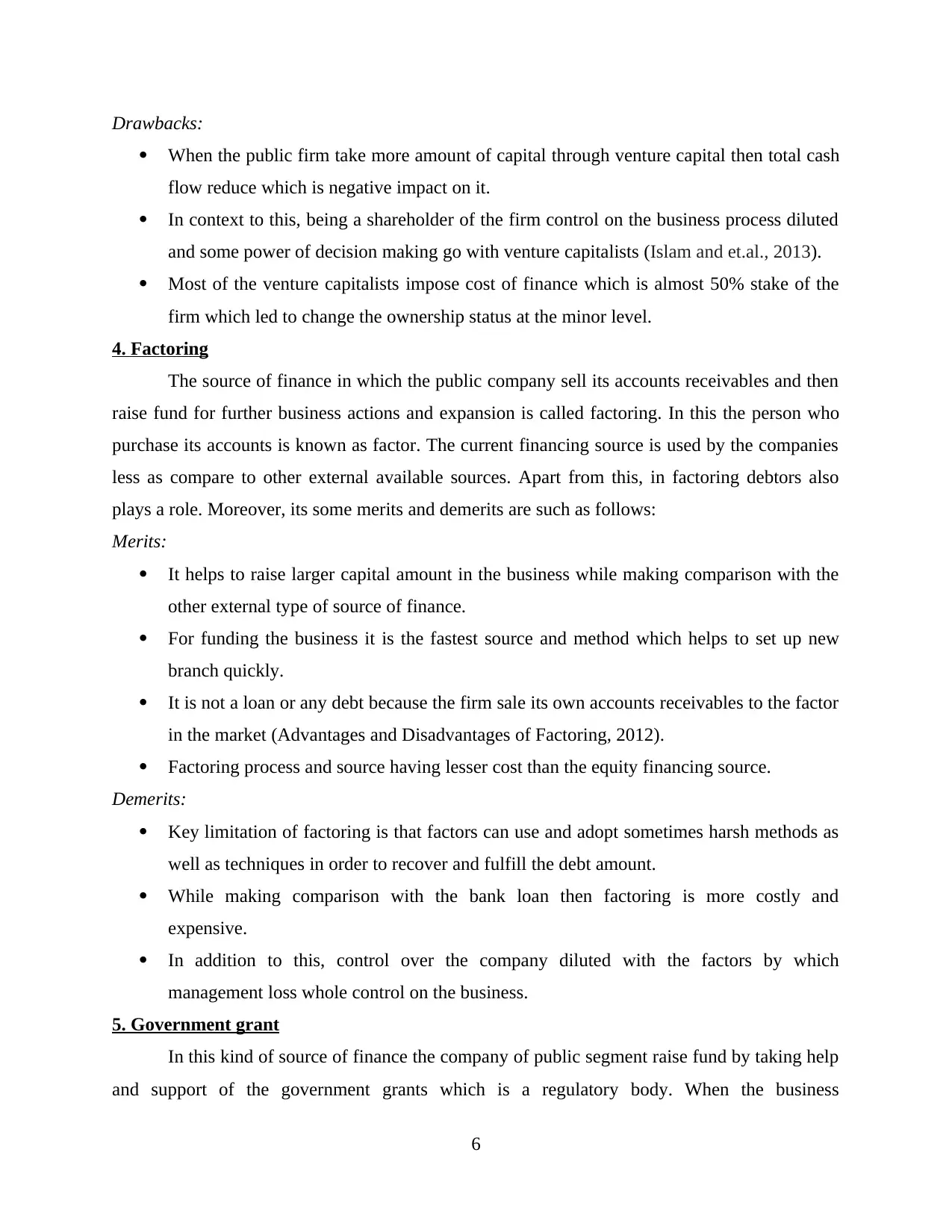
Drawbacks:
When the public firm take more amount of capital through venture capital then total cash
flow reduce which is negative impact on it.
In context to this, being a shareholder of the firm control on the business process diluted
and some power of decision making go with venture capitalists (Islam and et.al., 2013).
Most of the venture capitalists impose cost of finance which is almost 50% stake of the
firm which led to change the ownership status at the minor level.
4. Factoring
The source of finance in which the public company sell its accounts receivables and then
raise fund for further business actions and expansion is called factoring. In this the person who
purchase its accounts is known as factor. The current financing source is used by the companies
less as compare to other external available sources. Apart from this, in factoring debtors also
plays a role. Moreover, its some merits and demerits are such as follows:
Merits:
It helps to raise larger capital amount in the business while making comparison with the
other external type of source of finance.
For funding the business it is the fastest source and method which helps to set up new
branch quickly.
It is not a loan or any debt because the firm sale its own accounts receivables to the factor
in the market (Advantages and Disadvantages of Factoring, 2012).
Factoring process and source having lesser cost than the equity financing source.
Demerits:
Key limitation of factoring is that factors can use and adopt sometimes harsh methods as
well as techniques in order to recover and fulfill the debt amount.
While making comparison with the bank loan then factoring is more costly and
expensive.
In addition to this, control over the company diluted with the factors by which
management loss whole control on the business.
5. Government grant
In this kind of source of finance the company of public segment raise fund by taking help
and support of the government grants which is a regulatory body. When the business
6
When the public firm take more amount of capital through venture capital then total cash
flow reduce which is negative impact on it.
In context to this, being a shareholder of the firm control on the business process diluted
and some power of decision making go with venture capitalists (Islam and et.al., 2013).
Most of the venture capitalists impose cost of finance which is almost 50% stake of the
firm which led to change the ownership status at the minor level.
4. Factoring
The source of finance in which the public company sell its accounts receivables and then
raise fund for further business actions and expansion is called factoring. In this the person who
purchase its accounts is known as factor. The current financing source is used by the companies
less as compare to other external available sources. Apart from this, in factoring debtors also
plays a role. Moreover, its some merits and demerits are such as follows:
Merits:
It helps to raise larger capital amount in the business while making comparison with the
other external type of source of finance.
For funding the business it is the fastest source and method which helps to set up new
branch quickly.
It is not a loan or any debt because the firm sale its own accounts receivables to the factor
in the market (Advantages and Disadvantages of Factoring, 2012).
Factoring process and source having lesser cost than the equity financing source.
Demerits:
Key limitation of factoring is that factors can use and adopt sometimes harsh methods as
well as techniques in order to recover and fulfill the debt amount.
While making comparison with the bank loan then factoring is more costly and
expensive.
In addition to this, control over the company diluted with the factors by which
management loss whole control on the business.
5. Government grant
In this kind of source of finance the company of public segment raise fund by taking help
and support of the government grants which is a regulatory body. When the business
6
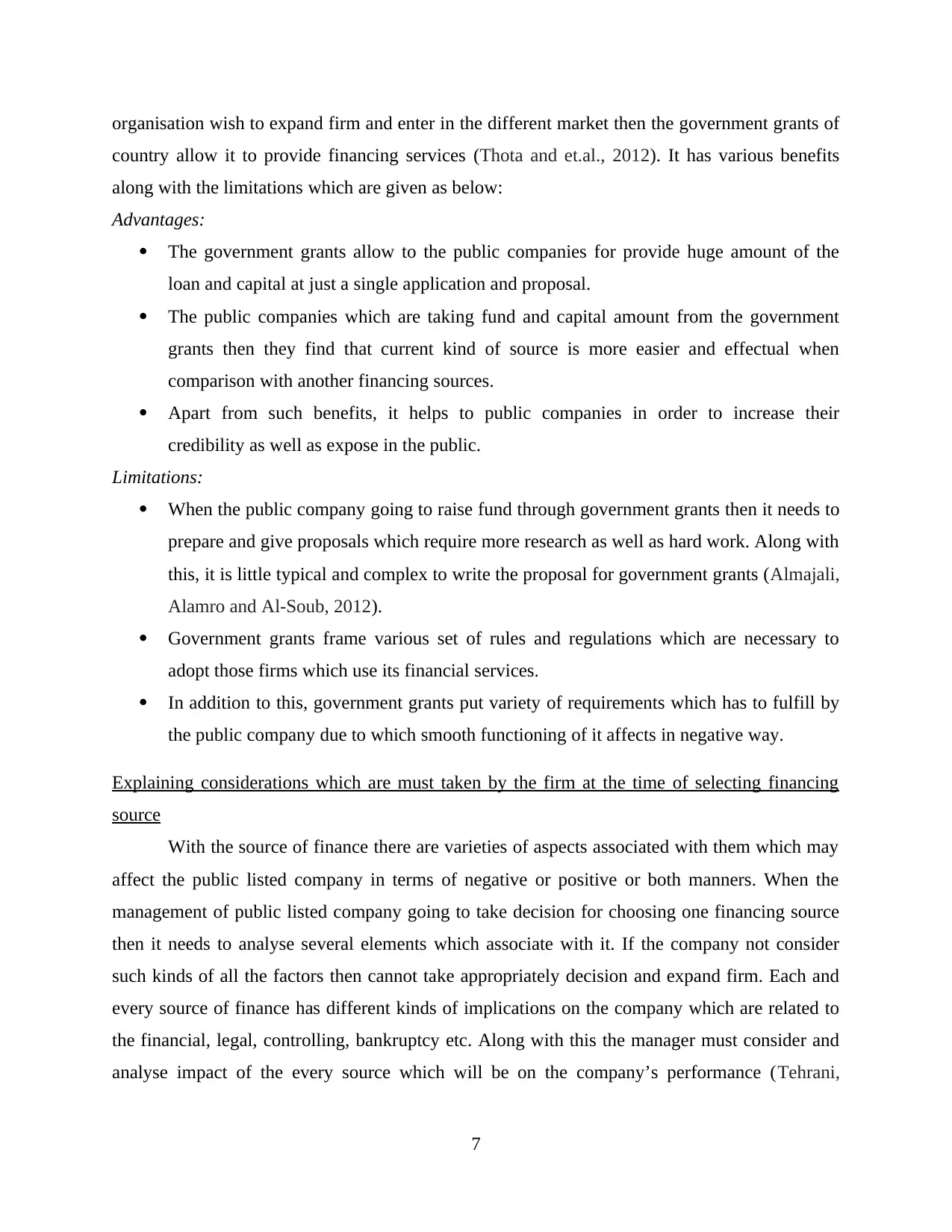
organisation wish to expand firm and enter in the different market then the government grants of
country allow it to provide financing services (Thota and et.al., 2012). It has various benefits
along with the limitations which are given as below:
Advantages:
The government grants allow to the public companies for provide huge amount of the
loan and capital at just a single application and proposal.
The public companies which are taking fund and capital amount from the government
grants then they find that current kind of source is more easier and effectual when
comparison with another financing sources.
Apart from such benefits, it helps to public companies in order to increase their
credibility as well as expose in the public.
Limitations:
When the public company going to raise fund through government grants then it needs to
prepare and give proposals which require more research as well as hard work. Along with
this, it is little typical and complex to write the proposal for government grants (Almajali,
Alamro and Al-Soub, 2012).
Government grants frame various set of rules and regulations which are necessary to
adopt those firms which use its financial services.
In addition to this, government grants put variety of requirements which has to fulfill by
the public company due to which smooth functioning of it affects in negative way.
Explaining considerations which are must taken by the firm at the time of selecting financing
source
With the source of finance there are varieties of aspects associated with them which may
affect the public listed company in terms of negative or positive or both manners. When the
management of public listed company going to take decision for choosing one financing source
then it needs to analyse several elements which associate with it. If the company not consider
such kinds of all the factors then cannot take appropriately decision and expand firm. Each and
every source of finance has different kinds of implications on the company which are related to
the financial, legal, controlling, bankruptcy etc. Along with this the manager must consider and
analyse impact of the every source which will be on the company’s performance (Tehrani,
7
country allow it to provide financing services (Thota and et.al., 2012). It has various benefits
along with the limitations which are given as below:
Advantages:
The government grants allow to the public companies for provide huge amount of the
loan and capital at just a single application and proposal.
The public companies which are taking fund and capital amount from the government
grants then they find that current kind of source is more easier and effectual when
comparison with another financing sources.
Apart from such benefits, it helps to public companies in order to increase their
credibility as well as expose in the public.
Limitations:
When the public company going to raise fund through government grants then it needs to
prepare and give proposals which require more research as well as hard work. Along with
this, it is little typical and complex to write the proposal for government grants (Almajali,
Alamro and Al-Soub, 2012).
Government grants frame various set of rules and regulations which are necessary to
adopt those firms which use its financial services.
In addition to this, government grants put variety of requirements which has to fulfill by
the public company due to which smooth functioning of it affects in negative way.
Explaining considerations which are must taken by the firm at the time of selecting financing
source
With the source of finance there are varieties of aspects associated with them which may
affect the public listed company in terms of negative or positive or both manners. When the
management of public listed company going to take decision for choosing one financing source
then it needs to analyse several elements which associate with it. If the company not consider
such kinds of all the factors then cannot take appropriately decision and expand firm. Each and
every source of finance has different kinds of implications on the company which are related to
the financial, legal, controlling, bankruptcy etc. Along with this the manager must consider and
analyse impact of the every source which will be on the company’s performance (Tehrani,
7
Paraphrase This Document
Need a fresh take? Get an instant paraphrase of this document with our AI Paraphraser
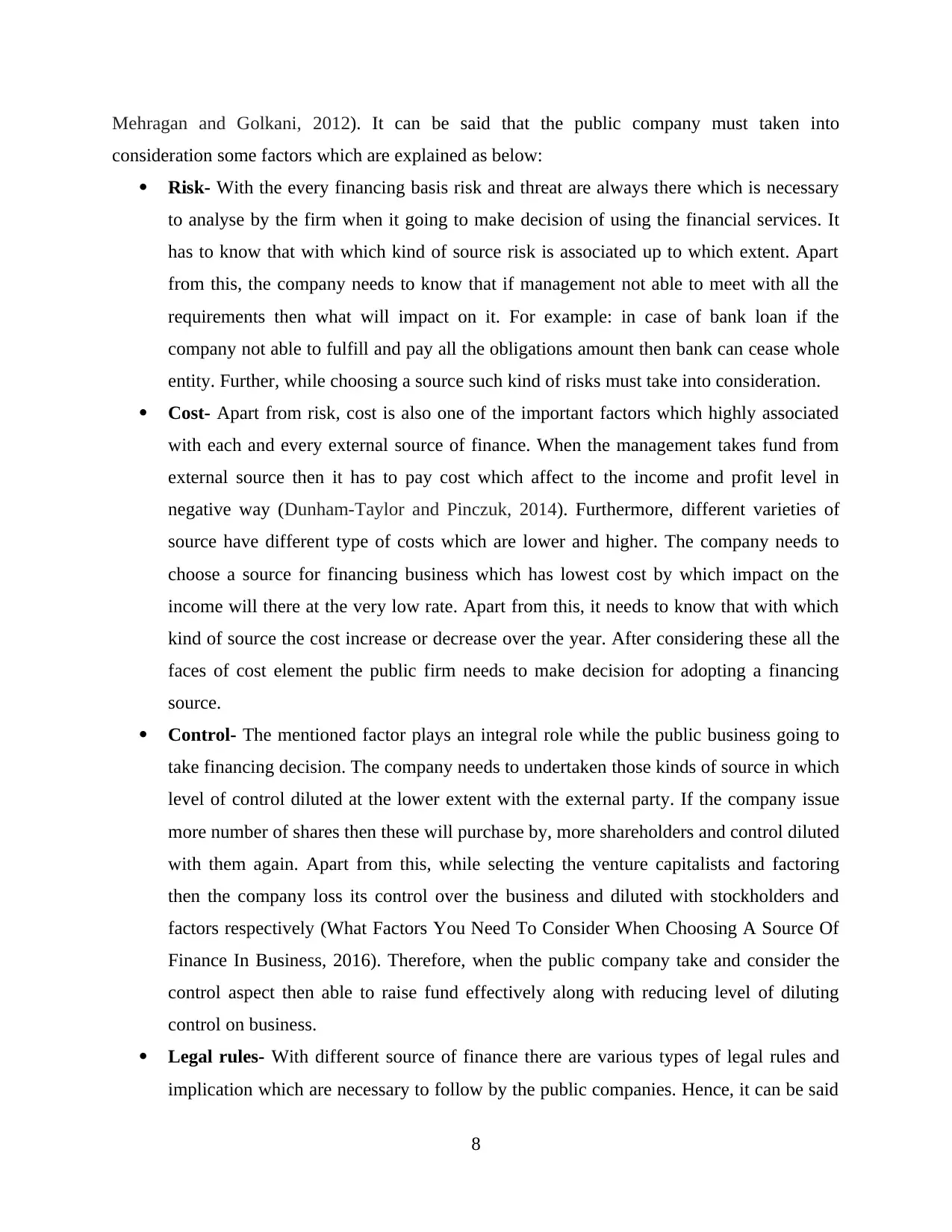
Mehragan and Golkani, 2012). It can be said that the public company must taken into
consideration some factors which are explained as below:
Risk- With the every financing basis risk and threat are always there which is necessary
to analyse by the firm when it going to make decision of using the financial services. It
has to know that with which kind of source risk is associated up to which extent. Apart
from this, the company needs to know that if management not able to meet with all the
requirements then what will impact on it. For example: in case of bank loan if the
company not able to fulfill and pay all the obligations amount then bank can cease whole
entity. Further, while choosing a source such kind of risks must take into consideration.
Cost- Apart from risk, cost is also one of the important factors which highly associated
with each and every external source of finance. When the management takes fund from
external source then it has to pay cost which affect to the income and profit level in
negative way (Dunham-Taylor and Pinczuk, 2014). Furthermore, different varieties of
source have different type of costs which are lower and higher. The company needs to
choose a source for financing business which has lowest cost by which impact on the
income will there at the very low rate. Apart from this, it needs to know that with which
kind of source the cost increase or decrease over the year. After considering these all the
faces of cost element the public firm needs to make decision for adopting a financing
source.
Control- The mentioned factor plays an integral role while the public business going to
take financing decision. The company needs to undertaken those kinds of source in which
level of control diluted at the lower extent with the external party. If the company issue
more number of shares then these will purchase by, more shareholders and control diluted
with them again. Apart from this, while selecting the venture capitalists and factoring
then the company loss its control over the business and diluted with stockholders and
factors respectively (What Factors You Need To Consider When Choosing A Source Of
Finance In Business, 2016). Therefore, when the public company take and consider the
control aspect then able to raise fund effectively along with reducing level of diluting
control on business.
Legal rules- With different source of finance there are various types of legal rules and
implication which are necessary to follow by the public companies. Hence, it can be said
8
consideration some factors which are explained as below:
Risk- With the every financing basis risk and threat are always there which is necessary
to analyse by the firm when it going to make decision of using the financial services. It
has to know that with which kind of source risk is associated up to which extent. Apart
from this, the company needs to know that if management not able to meet with all the
requirements then what will impact on it. For example: in case of bank loan if the
company not able to fulfill and pay all the obligations amount then bank can cease whole
entity. Further, while choosing a source such kind of risks must take into consideration.
Cost- Apart from risk, cost is also one of the important factors which highly associated
with each and every external source of finance. When the management takes fund from
external source then it has to pay cost which affect to the income and profit level in
negative way (Dunham-Taylor and Pinczuk, 2014). Furthermore, different varieties of
source have different type of costs which are lower and higher. The company needs to
choose a source for financing business which has lowest cost by which impact on the
income will there at the very low rate. Apart from this, it needs to know that with which
kind of source the cost increase or decrease over the year. After considering these all the
faces of cost element the public firm needs to make decision for adopting a financing
source.
Control- The mentioned factor plays an integral role while the public business going to
take financing decision. The company needs to undertaken those kinds of source in which
level of control diluted at the lower extent with the external party. If the company issue
more number of shares then these will purchase by, more shareholders and control diluted
with them again. Apart from this, while selecting the venture capitalists and factoring
then the company loss its control over the business and diluted with stockholders and
factors respectively (What Factors You Need To Consider When Choosing A Source Of
Finance In Business, 2016). Therefore, when the public company take and consider the
control aspect then able to raise fund effectively along with reducing level of diluting
control on business.
Legal rules- With different source of finance there are various types of legal rules and
implication which are necessary to follow by the public companies. Hence, it can be said
8
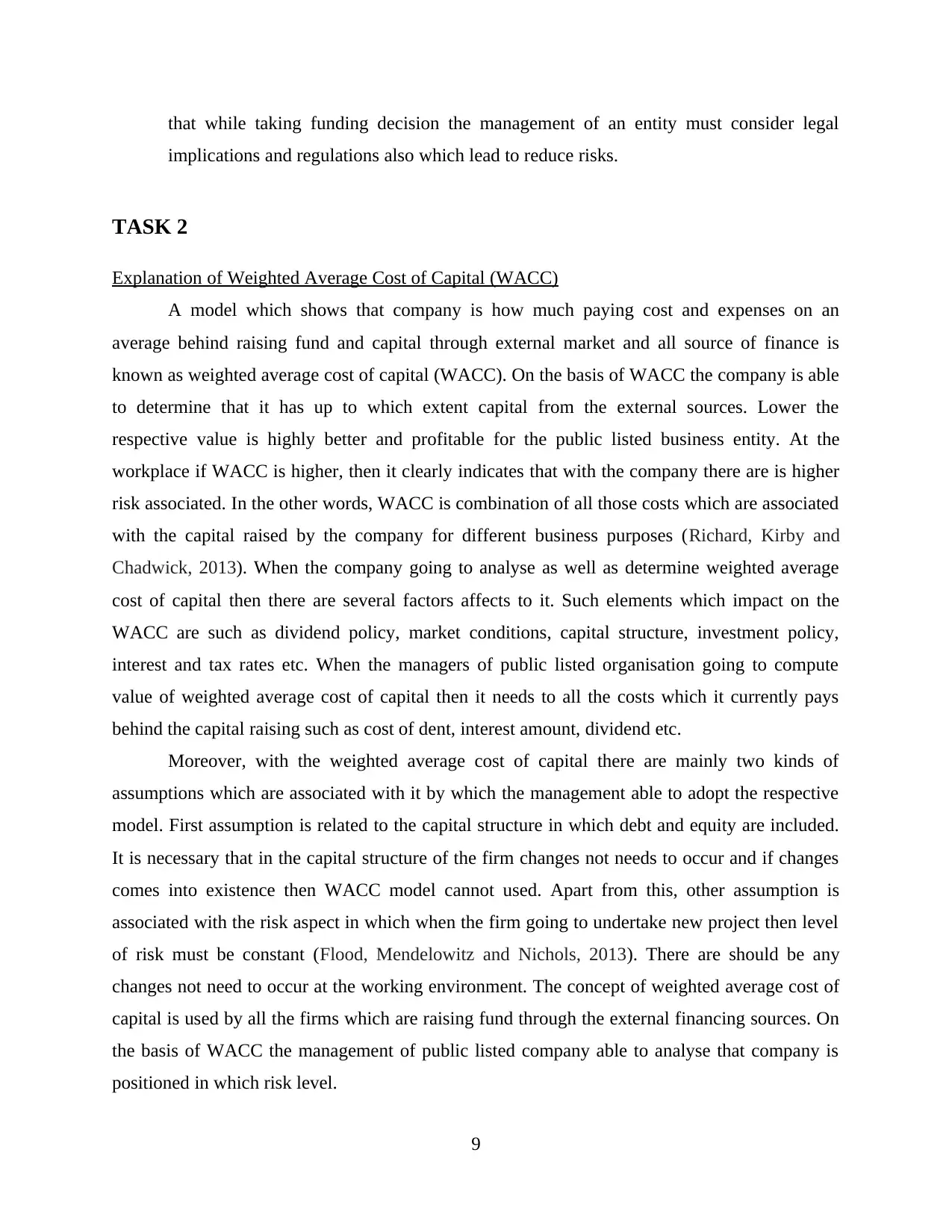
that while taking funding decision the management of an entity must consider legal
implications and regulations also which lead to reduce risks.
TASK 2
Explanation of Weighted Average Cost of Capital (WACC)
A model which shows that company is how much paying cost and expenses on an
average behind raising fund and capital through external market and all source of finance is
known as weighted average cost of capital (WACC). On the basis of WACC the company is able
to determine that it has up to which extent capital from the external sources. Lower the
respective value is highly better and profitable for the public listed business entity. At the
workplace if WACC is higher, then it clearly indicates that with the company there are is higher
risk associated. In the other words, WACC is combination of all those costs which are associated
with the capital raised by the company for different business purposes (Richard, Kirby and
Chadwick, 2013). When the company going to analyse as well as determine weighted average
cost of capital then there are several factors affects to it. Such elements which impact on the
WACC are such as dividend policy, market conditions, capital structure, investment policy,
interest and tax rates etc. When the managers of public listed organisation going to compute
value of weighted average cost of capital then it needs to all the costs which it currently pays
behind the capital raising such as cost of dent, interest amount, dividend etc.
Moreover, with the weighted average cost of capital there are mainly two kinds of
assumptions which are associated with it by which the management able to adopt the respective
model. First assumption is related to the capital structure in which debt and equity are included.
It is necessary that in the capital structure of the firm changes not needs to occur and if changes
comes into existence then WACC model cannot used. Apart from this, other assumption is
associated with the risk aspect in which when the firm going to undertake new project then level
of risk must be constant (Flood, Mendelowitz and Nichols, 2013). There are should be any
changes not need to occur at the working environment. The concept of weighted average cost of
capital is used by all the firms which are raising fund through the external financing sources. On
the basis of WACC the management of public listed company able to analyse that company is
positioned in which risk level.
9
implications and regulations also which lead to reduce risks.
TASK 2
Explanation of Weighted Average Cost of Capital (WACC)
A model which shows that company is how much paying cost and expenses on an
average behind raising fund and capital through external market and all source of finance is
known as weighted average cost of capital (WACC). On the basis of WACC the company is able
to determine that it has up to which extent capital from the external sources. Lower the
respective value is highly better and profitable for the public listed business entity. At the
workplace if WACC is higher, then it clearly indicates that with the company there are is higher
risk associated. In the other words, WACC is combination of all those costs which are associated
with the capital raised by the company for different business purposes (Richard, Kirby and
Chadwick, 2013). When the company going to analyse as well as determine weighted average
cost of capital then there are several factors affects to it. Such elements which impact on the
WACC are such as dividend policy, market conditions, capital structure, investment policy,
interest and tax rates etc. When the managers of public listed organisation going to compute
value of weighted average cost of capital then it needs to all the costs which it currently pays
behind the capital raising such as cost of dent, interest amount, dividend etc.
Moreover, with the weighted average cost of capital there are mainly two kinds of
assumptions which are associated with it by which the management able to adopt the respective
model. First assumption is related to the capital structure in which debt and equity are included.
It is necessary that in the capital structure of the firm changes not needs to occur and if changes
comes into existence then WACC model cannot used. Apart from this, other assumption is
associated with the risk aspect in which when the firm going to undertake new project then level
of risk must be constant (Flood, Mendelowitz and Nichols, 2013). There are should be any
changes not need to occur at the working environment. The concept of weighted average cost of
capital is used by all the firms which are raising fund through the external financing sources. On
the basis of WACC the management of public listed company able to analyse that company is
positioned in which risk level.
9
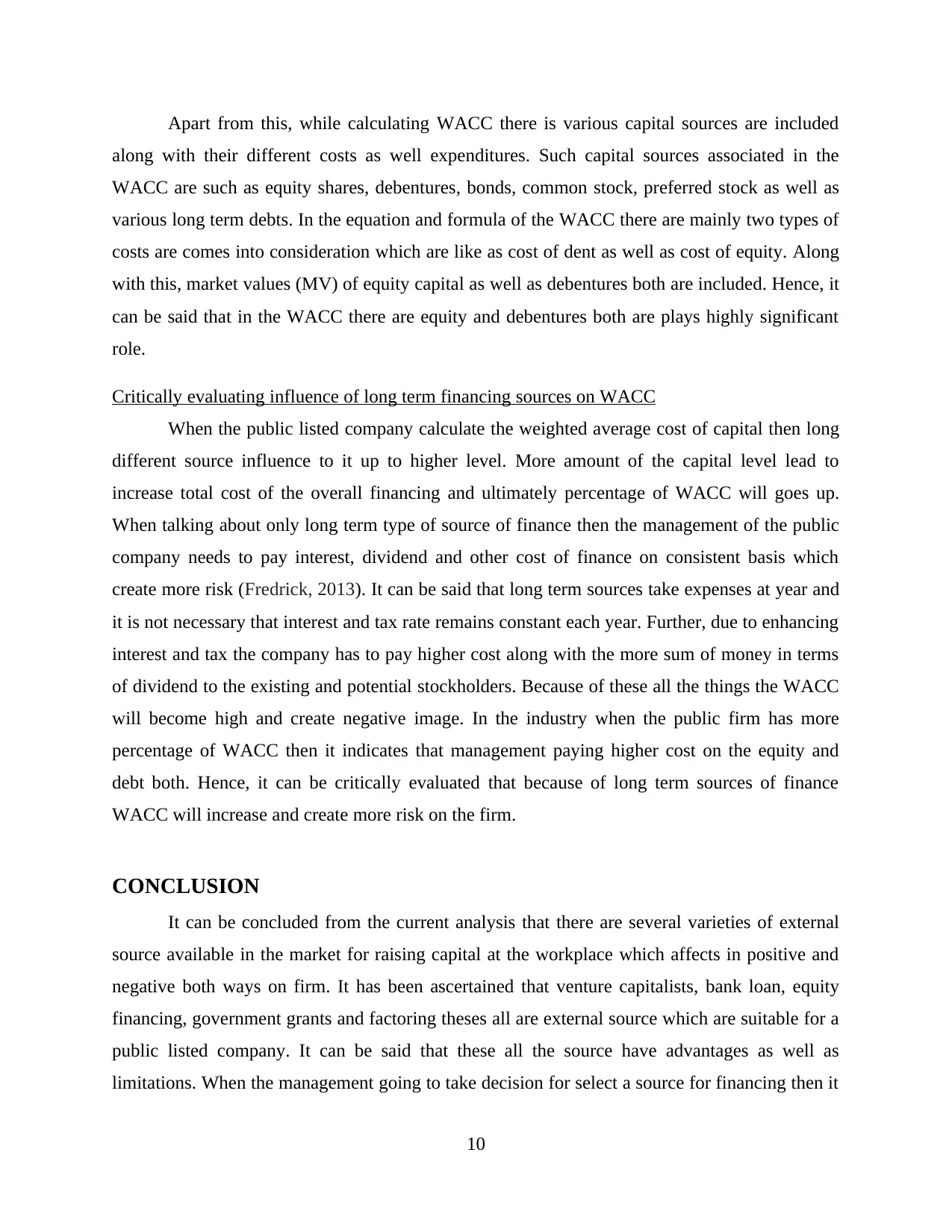
Apart from this, while calculating WACC there is various capital sources are included
along with their different costs as well expenditures. Such capital sources associated in the
WACC are such as equity shares, debentures, bonds, common stock, preferred stock as well as
various long term debts. In the equation and formula of the WACC there are mainly two types of
costs are comes into consideration which are like as cost of dent as well as cost of equity. Along
with this, market values (MV) of equity capital as well as debentures both are included. Hence, it
can be said that in the WACC there are equity and debentures both are plays highly significant
role.
Critically evaluating influence of long term financing sources on WACC
When the public listed company calculate the weighted average cost of capital then long
different source influence to it up to higher level. More amount of the capital level lead to
increase total cost of the overall financing and ultimately percentage of WACC will goes up.
When talking about only long term type of source of finance then the management of the public
company needs to pay interest, dividend and other cost of finance on consistent basis which
create more risk (Fredrick, 2013). It can be said that long term sources take expenses at year and
it is not necessary that interest and tax rate remains constant each year. Further, due to enhancing
interest and tax the company has to pay higher cost along with the more sum of money in terms
of dividend to the existing and potential stockholders. Because of these all the things the WACC
will become high and create negative image. In the industry when the public firm has more
percentage of WACC then it indicates that management paying higher cost on the equity and
debt both. Hence, it can be critically evaluated that because of long term sources of finance
WACC will increase and create more risk on the firm.
CONCLUSION
It can be concluded from the current analysis that there are several varieties of external
source available in the market for raising capital at the workplace which affects in positive and
negative both ways on firm. It has been ascertained that venture capitalists, bank loan, equity
financing, government grants and factoring theses all are external source which are suitable for a
public listed company. It can be said that these all the source have advantages as well as
limitations. When the management going to take decision for select a source for financing then it
10
along with their different costs as well expenditures. Such capital sources associated in the
WACC are such as equity shares, debentures, bonds, common stock, preferred stock as well as
various long term debts. In the equation and formula of the WACC there are mainly two types of
costs are comes into consideration which are like as cost of dent as well as cost of equity. Along
with this, market values (MV) of equity capital as well as debentures both are included. Hence, it
can be said that in the WACC there are equity and debentures both are plays highly significant
role.
Critically evaluating influence of long term financing sources on WACC
When the public listed company calculate the weighted average cost of capital then long
different source influence to it up to higher level. More amount of the capital level lead to
increase total cost of the overall financing and ultimately percentage of WACC will goes up.
When talking about only long term type of source of finance then the management of the public
company needs to pay interest, dividend and other cost of finance on consistent basis which
create more risk (Fredrick, 2013). It can be said that long term sources take expenses at year and
it is not necessary that interest and tax rate remains constant each year. Further, due to enhancing
interest and tax the company has to pay higher cost along with the more sum of money in terms
of dividend to the existing and potential stockholders. Because of these all the things the WACC
will become high and create negative image. In the industry when the public firm has more
percentage of WACC then it indicates that management paying higher cost on the equity and
debt both. Hence, it can be critically evaluated that because of long term sources of finance
WACC will increase and create more risk on the firm.
CONCLUSION
It can be concluded from the current analysis that there are several varieties of external
source available in the market for raising capital at the workplace which affects in positive and
negative both ways on firm. It has been ascertained that venture capitalists, bank loan, equity
financing, government grants and factoring theses all are external source which are suitable for a
public listed company. It can be said that these all the source have advantages as well as
limitations. When the management going to take decision for select a source for financing then it
10
Secure Best Marks with AI Grader
Need help grading? Try our AI Grader for instant feedback on your assignments.

needs to consider risk, cost, control as well as legal aspects which are associated with all the
sources. Further, it can be summarized that when the company has long term debt then it leads to
increase weighted cost of capital (WACC) of a public listed company.
11
sources. Further, it can be summarized that when the company has long term debt then it leads to
increase weighted cost of capital (WACC) of a public listed company.
11
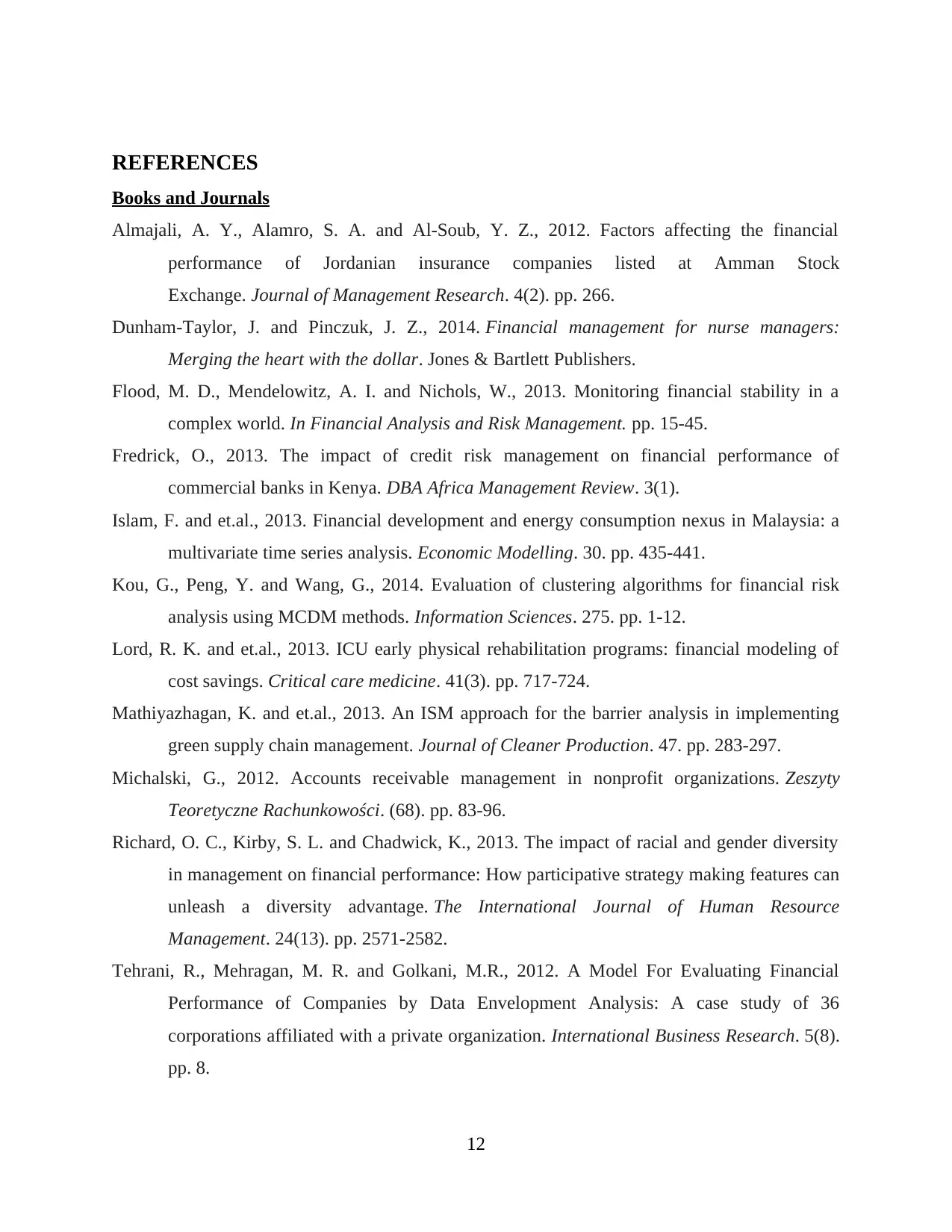
REFERENCES
Books and Journals
Almajali, A. Y., Alamro, S. A. and Al-Soub, Y. Z., 2012. Factors affecting the financial
performance of Jordanian insurance companies listed at Amman Stock
Exchange. Journal of Management Research. 4(2). pp. 266.
Dunham-Taylor, J. and Pinczuk, J. Z., 2014. Financial management for nurse managers:
Merging the heart with the dollar. Jones & Bartlett Publishers.
Flood, M. D., Mendelowitz, A. I. and Nichols, W., 2013. Monitoring financial stability in a
complex world. In Financial Analysis and Risk Management. pp. 15-45.
Fredrick, O., 2013. The impact of credit risk management on financial performance of
commercial banks in Kenya. DBA Africa Management Review. 3(1).
Islam, F. and et.al., 2013. Financial development and energy consumption nexus in Malaysia: a
multivariate time series analysis. Economic Modelling. 30. pp. 435-441.
Kou, G., Peng, Y. and Wang, G., 2014. Evaluation of clustering algorithms for financial risk
analysis using MCDM methods. Information Sciences. 275. pp. 1-12.
Lord, R. K. and et.al., 2013. ICU early physical rehabilitation programs: financial modeling of
cost savings. Critical care medicine. 41(3). pp. 717-724.
Mathiyazhagan, K. and et.al., 2013. An ISM approach for the barrier analysis in implementing
green supply chain management. Journal of Cleaner Production. 47. pp. 283-297.
Michalski, G., 2012. Accounts receivable management in nonprofit organizations. Zeszyty
Teoretyczne Rachunkowości. (68). pp. 83-96.
Richard, O. C., Kirby, S. L. and Chadwick, K., 2013. The impact of racial and gender diversity
in management on financial performance: How participative strategy making features can
unleash a diversity advantage. The International Journal of Human Resource
Management. 24(13). pp. 2571-2582.
Tehrani, R., Mehragan, M. R. and Golkani, M.R., 2012. A Model For Evaluating Financial
Performance of Companies by Data Envelopment Analysis: A case study of 36
corporations affiliated with a private organization. International Business Research. 5(8).
pp. 8.
12
Books and Journals
Almajali, A. Y., Alamro, S. A. and Al-Soub, Y. Z., 2012. Factors affecting the financial
performance of Jordanian insurance companies listed at Amman Stock
Exchange. Journal of Management Research. 4(2). pp. 266.
Dunham-Taylor, J. and Pinczuk, J. Z., 2014. Financial management for nurse managers:
Merging the heart with the dollar. Jones & Bartlett Publishers.
Flood, M. D., Mendelowitz, A. I. and Nichols, W., 2013. Monitoring financial stability in a
complex world. In Financial Analysis and Risk Management. pp. 15-45.
Fredrick, O., 2013. The impact of credit risk management on financial performance of
commercial banks in Kenya. DBA Africa Management Review. 3(1).
Islam, F. and et.al., 2013. Financial development and energy consumption nexus in Malaysia: a
multivariate time series analysis. Economic Modelling. 30. pp. 435-441.
Kou, G., Peng, Y. and Wang, G., 2014. Evaluation of clustering algorithms for financial risk
analysis using MCDM methods. Information Sciences. 275. pp. 1-12.
Lord, R. K. and et.al., 2013. ICU early physical rehabilitation programs: financial modeling of
cost savings. Critical care medicine. 41(3). pp. 717-724.
Mathiyazhagan, K. and et.al., 2013. An ISM approach for the barrier analysis in implementing
green supply chain management. Journal of Cleaner Production. 47. pp. 283-297.
Michalski, G., 2012. Accounts receivable management in nonprofit organizations. Zeszyty
Teoretyczne Rachunkowości. (68). pp. 83-96.
Richard, O. C., Kirby, S. L. and Chadwick, K., 2013. The impact of racial and gender diversity
in management on financial performance: How participative strategy making features can
unleash a diversity advantage. The International Journal of Human Resource
Management. 24(13). pp. 2571-2582.
Tehrani, R., Mehragan, M. R. and Golkani, M.R., 2012. A Model For Evaluating Financial
Performance of Companies by Data Envelopment Analysis: A case study of 36
corporations affiliated with a private organization. International Business Research. 5(8).
pp. 8.
12
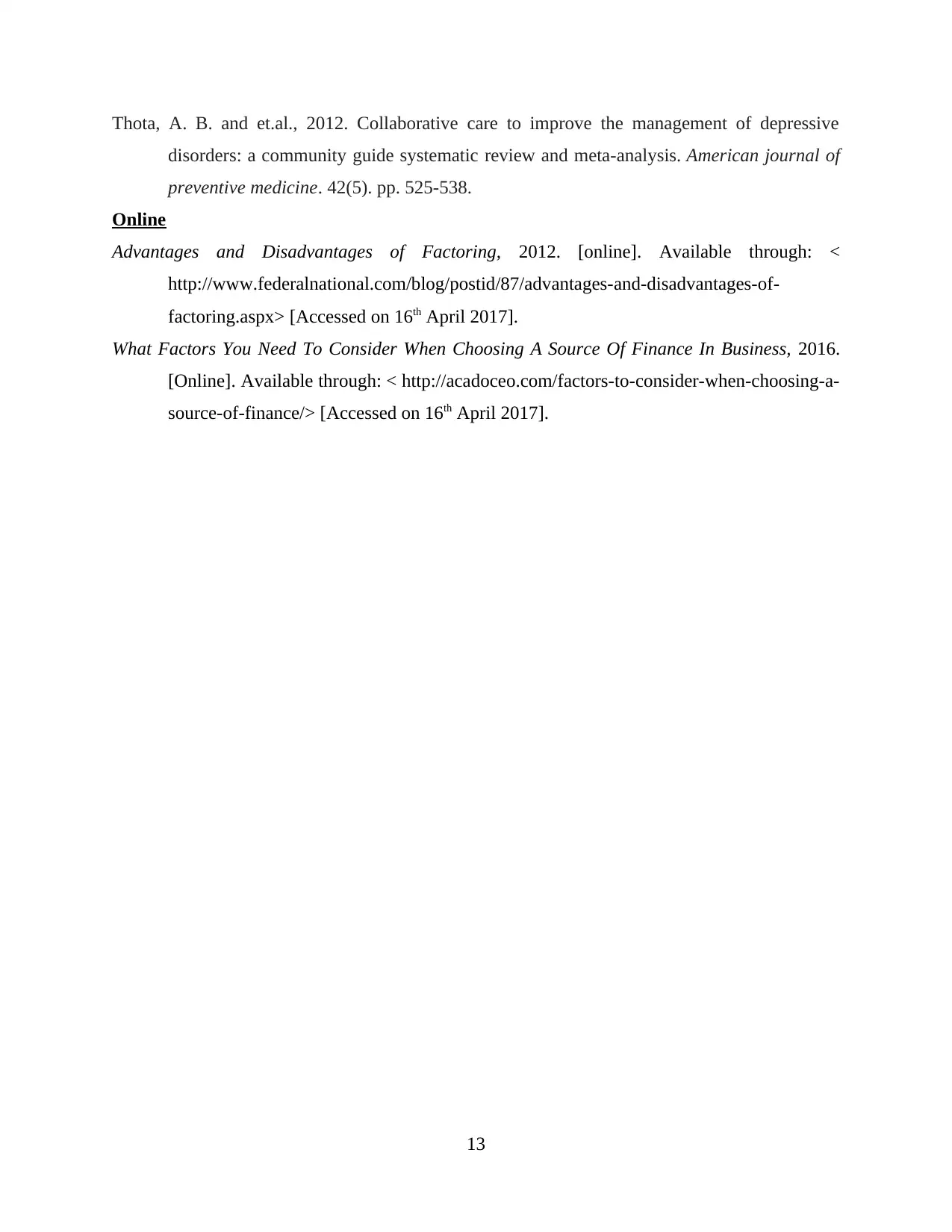
Thota, A. B. and et.al., 2012. Collaborative care to improve the management of depressive
disorders: a community guide systematic review and meta-analysis. American journal of
preventive medicine. 42(5). pp. 525-538.
Online
Advantages and Disadvantages of Factoring, 2012. [online]. Available through: <
http://www.federalnational.com/blog/postid/87/advantages-and-disadvantages-of-
factoring.aspx> [Accessed on 16th April 2017].
What Factors You Need To Consider When Choosing A Source Of Finance In Business, 2016.
[Online]. Available through: < http://acadoceo.com/factors-to-consider-when-choosing-a-
source-of-finance/> [Accessed on 16th April 2017].
13
disorders: a community guide systematic review and meta-analysis. American journal of
preventive medicine. 42(5). pp. 525-538.
Online
Advantages and Disadvantages of Factoring, 2012. [online]. Available through: <
http://www.federalnational.com/blog/postid/87/advantages-and-disadvantages-of-
factoring.aspx> [Accessed on 16th April 2017].
What Factors You Need To Consider When Choosing A Source Of Finance In Business, 2016.
[Online]. Available through: < http://acadoceo.com/factors-to-consider-when-choosing-a-
source-of-finance/> [Accessed on 16th April 2017].
13
1 out of 13
Related Documents
Your All-in-One AI-Powered Toolkit for Academic Success.
+13062052269
info@desklib.com
Available 24*7 on WhatsApp / Email
![[object Object]](/_next/static/media/star-bottom.7253800d.svg)
Unlock your academic potential
© 2024 | Zucol Services PVT LTD | All rights reserved.




